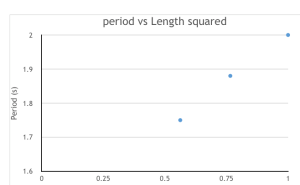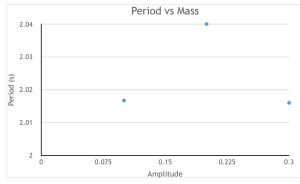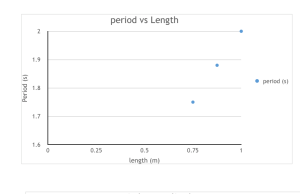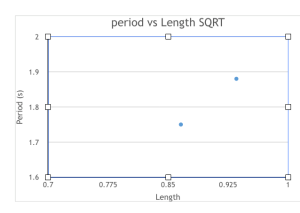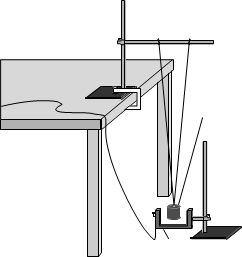Purpose: to determine what would affect the period of a pendulum, changing the variable of mass, length, and amplitude.
Find a away to fix the Grandfather Clock’s Pendulum by changing only these variables to a period of 1.875.
Equipment:
- Ring Stand and Clamps
- Pendulum Clamp
- Photogate
- Laptop with LabPro Software
- LabPro Quest
- Connector Cables
- Mass Weight Set
- Protractor
- Meterstick
Procedure:
- Place a support stand on the edge of a table and secure it to the table with a clamp or by placing a heavy mass on the base. Tie two strings of equal length to the 200 g mass. Attach the strings about 15 cm apart to a horizontal rod extended from the support stand. The pendulum should hang over the edge of the table, as shown on the previous page. This arrangement will let the mass swing only along a line, and will prevent the mass from striking the photogate. The length of the pendulum is the distance from the point on the rod halfway between the strings to the center of the mass. The pendulum length should be at least 1 m (you do not need an exact measurement now).
- Attach the photogate to a second support stand. Place the support stand on the floor and position the photogate so that the mass blocks the photogate while hanging straight down. Connect the photogate to the LabPro and turn it on.
- Observe the reading on the screen. Temporarily hold the mass out of the center of the photogate. Block the photogate with your hand; note that the photogate is shown as blocked. When you remove your hand, the display should change to unblocked. Now, set the time mode.
- Select PENDULUM from the TIMING MODES menu.
- Now you can perform a trial measurement of the period of your pendulum.
Hold the mass displaced about 10° from vertical and release. (For a pendulum that is 100 cm long, that corresponds to pulling the mass about 15 cm to the side.) After the mass has passed through the photogate, the average period begins to display on the calculator screen.
Part I Amplitude
- Measure the period for five different amplitudes. Choose a wide range of amplitudes, from just barely enough to unblock the photogate, to about 30°. For each trial, use the protractor to measure the amplitude before releasing the mass. Collect the data and record it in a data table like the one shown for Part I in the Data Tables section.
Part II Length
- Now you will measure the effect of changing pendulum length on the period. Use a constant mass and consistent amplitude of 10° for each trial. Vary the pendulum length in steps of 10 cm, from 100 cm down to 50 cm. Be sure to measure the pendulum length from the rod to the center of the mass. You may have to raise the photogate as the length changes. Record your data in a data table like the one shown for Part II in the Data Tables section.
Part III Mass
- Use three different masses to determine if the period is affected by changing the mass. Be sure to attach the masses so that the center of mass remains unchanged; otherwise, you are also affecting the length. For each mass trial, keep the length of the pendulum the same and use constant amplitude of 10°. Repeat step 8 for each trial. Record your data in a data table like the one shown for Part III in the Data Tables section.
Design of Pendulum:
Data:
Amplitude (Degrees) Period (s)
10 2.025
20 2.029
30 2.036
40 2.054
Mass (kg) Period (s)
.1 2.0167
.2 2.04
.3 2.36
Length (m) Period (s)
1 2.085
.9 1.9785
.8 1.8445
.7 1.7785
.6 1.676
.5 1.543
Data Analysis:
T=k(sqrt(l))
K is represented in the slope of the line of the period vs. sqrt(l) graph. I found my slope to be .18.
1.875=.18(sqrtL)
L=.86 m
Conclusion:
T=k(sqrt(l))
We see from the graphs that the pendulum’s period is only affected when we change the length of the string. The mass and amplitude have nothing to do with the period of the pendulum. In order to find the period of 1.875 for the grandfather clock, we would have to adjust the length of the pendulum to be about .86 (found by the slope of the graph, using the period vs. sqrt(length) graph and using the relationship between that and the equation of the period of a pendulum, T=k(sqrt(l)) Some error that may have affected our results is the lack of superior equipment and the friction force and mass of the string.
